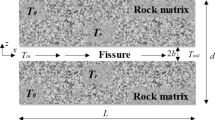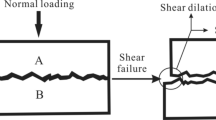Abstract
Zhangzhou geothermal field is one of the highest temperature in southeastern coastal areas in China. Zhangzhou geothermal field is an uplift-fracture type geothermal resource, and there are several deep fractures in the geothermal field, controlling water flow and heat transfer. Presently there is no systematic study of the characteristics of the temperature field, pressure field and water density distribution in the geothermal field, and there is no systematic analysis of the main factors affecting the temperature field. In this work, geological features of the fracture system are considered, and a conceptual model of the fracture system is established. Based on these, the distribution of the temperature field, pressure field and water density field at Zhangzhou geothermal field are numerically studied, the controlling effect of the fracture system on the temperature field is analyzed, and the main factors affecting the temperature field, pressure field and water density field are discussed. The results indicate that the temperature field and water density field at Zhangzhou geothermal field are strongly controlled by the fracture system, and the zone of high-temperature and low-density is confined within the fracture system. Main factors affecting the temperature field and water density field include the permeability of the fracture zone, the thermal conductivity of rocks and the water recharge rate. Higher fracture zone permeability will reduce the temperature and increase the water density in the center of the fracture system. Higher water recharge rate will increase the temperature and reduce the water density in the center of the fracture system.














Similar content being viewed by others
References
Guillou-Frottier L, Carrė C, Bourgine B, Bouchot V, Genter A (2013) Structure of hydrothermal convection in the Upper Rhine Graben as inferred from corrected temperature data and basin-scale numerical models. J Volcanol Geoth Res 256:29–49
Han QZ, Zhuang QX (1988) Study on the source and pathway of hot water in Zhangzhou Basin, Fujian. Earth Sci J China Univ Geosci 13(3):271–277 (in Chinese)
Hayba D, Ingebritsen S (1997) Multiphase groundwater flow near cooling plutons. J Geophys Res 102(B6):12235–12252
Hayba D, Ingebritsen S (1994) The computer model hydrotherm, a three-dimensional model to simulate ground-water flow and heat transport in the temperature range of 0 to 1200 C. U.S. geological survey. Water-Resour Invest Rep 94–4045.
Hu SB, Xiong LP (1990) Reservoir modeling of Zhangzhou low temperature fracture zone system, Fujian. China Geol Sci Technol Inf 9(4):65–71
Hu SB (1994) Distributed parameter model for the Zhangzhou geothermal field, China[C]. Geothermal training programme, Orkustofnun, Grensasvegur 9, IS-108 Reykjavik, Iceland, number 3, 1994.
McKenna JR, Blackwell DD (2004) Numerical modeling of transient Basin and range extensional geothermal systems. Geothermics 33(4):457–476
Moeck IS (2014) Catalog of geothermal play types based on geologic controls. Renew Sustain Energy Rev 37:867–882
Nian WZ (2008) Formation model of geothermal field and its relation with control structure in Zhangzhou. Safety Environ Eng 15(4):30–33 (in Chinese)
Pang ZH (1988) Basic features and genesis analysis of Zhangzhou geothermal field. Earth Sci Inf 3:62–63 (in Chinese)
Pang ZH, Wang JY, Fan ZC (1990) Reservoir temperature of Zhangzhou geothermal field calculated by SiO2 hybrid model. Chin Sci Bull 1:57–59 (in Chinese)
Pruess K, Oldenburg C, Moridis G (1999) TOUGH2 user’s guide, Version 2.0. Lawrence Berkeley National Laboratory, Berkeley
Scott S, Driesner T, Weis P (2016) The thermal structure and temporal evolution of high-enthalpy geothermal systems. Geothermics 62:33–47
Tester JW, Livesay B, Anderson BJ, Moore MC, Bathchelor AS, Nichols K, et al (2006) The future of geothermal energy: impact of Enhanced Geothermal Systems (EGS) on the United States in the 21st century. An assessment by an MIT-led interdisciplinary panel.
Wagner W, Kretzschmar HJ (2007) International steam tables-properties of water and steam based on the industrial formulation IAPWS-IF97, 2nd edn. Springer, Berlin
Wang CP (2006) Prognoses of possible land subsidence brought on by extraction of Geothermal resources in Zhangzhou city, Fujian Province. Geol Fujian 25(3):141–148 (in Chinese)
Weis P, Driesner T, Coumou D, Geiger S (2014) Hydrothermal, multiphase convection of H2O-NaCl fluids from ambient to magmatic temperatures: a new numerical scheme and benchmarks for code comparison. Geofluids 14:347–371
Wisian KW, Blackwell DD (2004) Numerical modeling of Basin and range geothermal systems. Geothermics 33(6):713–741
Xiong SB, Jin DM, Sun KZ (1991) Some characteristics of deep structure of the Zhangzhou geothermal field and its neighborhood in the Fujian Province. Acta Geophysica Sinica 34(1):55–63 (in Chinese)
Xiong LP, Wang JY, Pang ZH (1990a) Temperature pattern of Zhangzhou geothermal filed, Fujian Province, SE China. Scientia Geologica Sinica 1:70–80 (in Chinese)
Xiong LP, Wang JY, Pang ZH (1990b) Convective and conductive heat flows in Zhangzhou geothermal field, Fujian Province, China. Chin J Geophys 33(6):702–711 (in Chinese)
Xu SG, Guo YS (2009) Geothermal energy foundation. Science Press, Beijing (In Chinese)
Yang ZK, Hu SB, Hochstein MP (1990) Conceptual model of the Zhangzhou low temperature system and its surrounding catchment (Fujian Province, China). Proceedings in Fifteenth Workshop on Geothermal Reservoir Engineering. Stanford University, Stanford
Zeng Y, Su Z, Wu N (2013a) Numerical simulation of heat production potential from hot dry rock by water circulating through two horizontal wells at Desert Peak geothermal field. Energy 56(92):107
Zeng Y, Tang L, Wu N (2017) Analysis of influencing factors of production performance of enhanced geothermal system: a case study at Yangbajing geothermal field. Energy 127:218–235
Zeng Y, Wu N, Su Z (2013b) Numerical simulation of heat production potential from hot dry rock by water circulating through a novel single vertical fracture at Desert Peak geothermal field. Energy 63:268–282
Zeng Y, Zhan J, Wu N (2016a) Numerical simulation of electricity generation potential from fractured granite reservoir through vertical wells at Yangbajing geothermal field. Energy 103:290–304
Zeng Y, Zhan J, Wu N (2016b) Numerical investigation of electricity generation potential from fractured granite reservoir by water circulating through three horizontal wells at Yangbajing geothermal field. Appl Therm Eng 104:1–15
Zhang QX (1988) Discussion on thermogenetic model of Zhangzhou geothermal field. Earth Sci 13(3):335–339 (in Chinese)
Zhong SJ, Xu WY (1988) Numerical simulation of Zhangzhou geothermal field and its formation mechanism [C]. The past forty years of Institute of Geophysics, Chinese Academy of Science (1950–1990). Chinese Society for Rock Mechanics and Engineering, Beijing (in Chinese)
Acknowledgements
The authors gratefully appreciate the financial supports from the GDAS’ Project of Science and Technology Development (2020GDASYL-20200102020, 2020GDASYL-20200102013, 2020GDASYL-20200301003, 2020GDASYL-20200402003, 2020GDASYL-20200302007, 2019GDASYL-0102002), Guangdong Foundation for Program of Science and Technology Research (2019B121205006, 2019B121201004) and the National Natural Science Foundation of China (41930865). We also thank the supports from the Northern Guangdong Soil Environment Observation and Research Station, and the Guangdong Engineering Center of Non-point Source Pollution Control. This research wassupported by National Natural Science Foundation of China (Grant 41572277).
Author information
Authors and Affiliations
Contributions
YZ had established the numerical model and calculated the results. BH, LT and NW had checked the model and updated the model parameters. JS and ZZ had checked the computational results and refined the English language.
Corresponding authors
Ethics declarations
Conflict of Interest
The authors declare no conflict of interest.
Additional information
Publisher's Note
Springer Nature remains neutral with regard to jurisdictional claims in published maps and institutional affiliations.
Rights and permissions
About this article
Cite this article
Zeng, Y., He, B., Tang, L. et al. Numerical simulation of temperature field and pressure field of the fracture system at Zhangzhou geothermal field. Environ Earth Sci 79, 262 (2020). https://doi.org/10.1007/s12665-020-09018-y
Received:
Accepted:
Published:
DOI: https://doi.org/10.1007/s12665-020-09018-y




